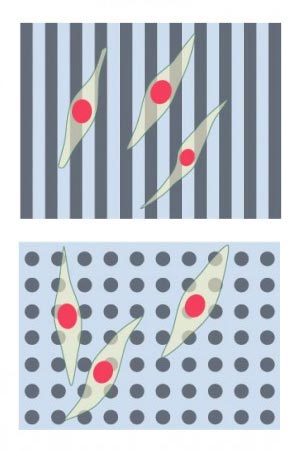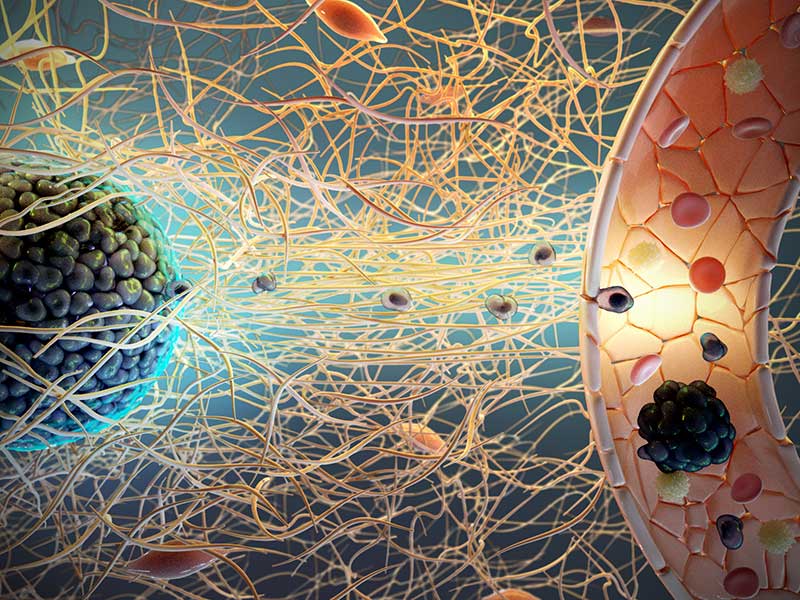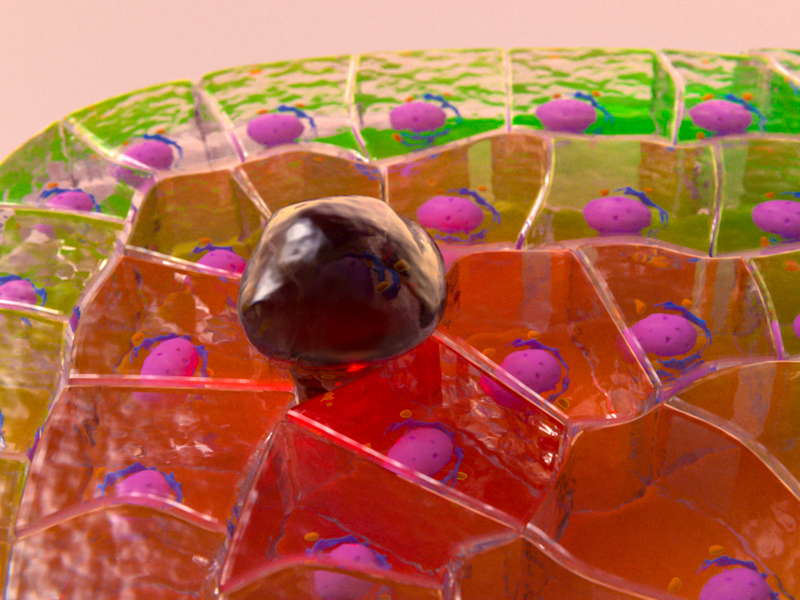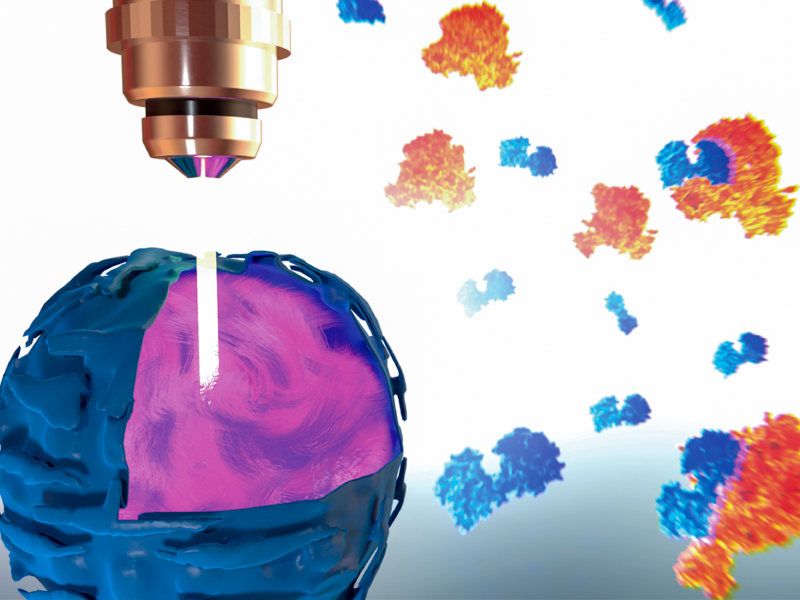Engineering novel platforms for experimentation
In order to advance our understanding of mechanobiology it is essential to characterize, in detail, the nano- and micro-scale changes that occur within cells as they respond to changes in their immediate environment. Such an approach requires tools that allow researchers to control or manipulate the physical parameters of a cell’s 3D environment, whilst simultaneously quantifying, with high precision, any changes in cell state. At the MBI we continue to produce innovative platforms that allow experimentation at various levels, from cell layers down to individual proteins.

Researchers at MBI have discovered the differential effects of extracellular matrix (ECM) topography on the proliferation of normal and cancerous cells. Read the full article: A Mechanical STOP Sign.
Particularly valuable is the ability to engineer microfabricated substrates with defined physical properties. These substrates may feature distinct patterns or topology, or comprise pillars that deflect under the force of a moving cell. By controlling the stiffness of the patterned substrate, or the height and flexibility of a pillar array, our researchers have been able to determine the effect the physical environment on cell growth and movement.
New methods for understanding
We have also successfully engineered a chip that allows the growth of single cells or cell doublets in a controlled 3D microenvironment. By using high-end super resolution microscopy to observe the growth and dynamics of single cells/cell doublets, we have characterized the influence of mechanical tension on the formation and function of cadherin-based cell-cell adhesion complexes.
Importantly, the surface chemistry of these microwell arrays can also be defined. This allows us to determine the effect of various components of the extracellular matrix on the growth and adhesive properties of cells in a 3D microenvironment. This approach has been used, for example, to define the development of lumens (tube like spaces) between liver cells.
These microwell arrays have also been adapted by MBI researchers in the development of a novel super-resolution microscopy technique called so-SPIM. Here, the wells are constructed with micro-mirrors, and are able to both direct an excitation beam for fluorescence microscopy, and serve to hold the sample. This method is developed around the principals of selective-plane illumination microscopy. As the micromirror/microwell array is developed independently of the microscope system, this method provides access to super-resolution microscopy, using conventional inverted microscopes.
Diagnostics and Therapetics
MBI is also actively engaging industry partners in the development of new diagnostic tools and therapeutics for a range of diseases. For example, microfluidic chips have been commercialized for use in biomedical assays for the early diagnosis, management, and treatment of cancers, following research conducted by MBI researchers. These devices exploit the differences in the physical properties of various cell types effectively isolate rare cancer cells from a large population of non-cancerous blood cells.
Integrating the knowledge obtained through our basic research programmes with the development of new experimental platforms enables us to innovate technologies that can be used as diagnostic, therapeutic and drug testing platforms in the healthcare industry.
Featured Research in Technology Innovation for Mechanobiology
The mechanics of cancer growth
How cancer cells spread in response to physical cues from their surroundings
Confined movements
How cells form tubes in confined spaces
Defects in Epithelial Tissue Organization
A question of life and death
Too Deep To Divide!
Molecular response to depth sensing differs in cancer cells
So-SPIM-FCS
A novel tool for imaging nuclear protein dynamics
B(a)iled Out
Actin remodeling drives bile regurgitation during obstructive cholestasis
Technology Innovation for Mechanobiology Researchers
LIM Chwee Teck
Collective cell migration, human disease mechanobiology, microfluidic technologies for disease detection and diagnosis, 2D materials for biomedical applications
YU Hanry
Innovative technologies for diagnostics, therapeutics and drug testing applications in pharmaceutical and healthcare industry
Virgile VIASNOFF
Cell-cell adhesion, microfabrication of controlled environment for cell culture, biophysics of single molecules
MBI Publications in Technology Innovation for Mechanobiology
Latest Publications
- Sheng B, Pushpanathan K, Guan Z, Lim QH, Lim ZW, Yew SME, Goh JHL, Bee YM, Sabanayagam C, Sevdalis N, Lim CC, Lim CT, Shaw J, Jia W, Ekinci EI, Simó R, Lim L, Li H, and Tham Y. Artificial intelligence for diabetes care: current and future prospects. Lancet Diabetes Endocrinol 2024; 12(8):569-595. [PMID: 39054035]
- Ma Y, Li Z, Luo Y, Chen Y, Ma L, Liu X, Xiao J, Huang M, Li Y, Jiang H, Wang M, Wang X, Li J, Kong J, Shi P, Yu H, Jiang X, and Guo Q. Biodegradable Microembolics with Nanografted Polyanions Enable High-Efficiency Drug Loading and Sustained Deep-Tumor Drug Penetration for Locoregional Chemoembolization Treatment. ACS Nano 2024;. [PMID: 38946122]
- Ong JLK, Jalaludin NFF, Wong MK, Tan SH, Angelina C, Sukhatme SA, Yeo T, Lim CT, Lee YT, Soh SY, Lim TKH, Tay TKY, Chang KTE, Chen ZX, and Loh AH. Exosomal mRNA Cargo are biomarkers of tumor and immune cell populations in pediatric osteosarcoma. Transl Oncol 2024; 46:102008. [PMID: 38852279]
- Liang L, Song X, Zhao H, and Lim CT. Insights into the mechanobiology of cancer metastasis via microfluidic technologies. APL Bioeng 2024; 8(2):021506. [PMID: 38841688]
- Wu Y, Cheng J, Qi J, Hang C, Dong R, Low BC, Yu H, and Jiang X. Three-dimensional liquid metal-based neuro-interfaces for human hippocampal organoids. Nat Commun 2024; 15(1):4047. [PMID: 38744873]
- Luo X, Wang J, Tan C, Dou Q, Han Z, Wang Z, Tasnim F, Wang X, Zhan Q, Li X, Zhou Q, Cheng J, Liao F, Yip HC, Jiang J, Tan RT, Liu S, and Yu H. Rapid Endoscopic Diagnosis of Benign Ulcerative Colorectal Diseases with an Artificial Intelligence Contextual Framework. Gastroenterology 2024;. [PMID: 38583724]
- Makhija E, Zheng Y, Wang J, Leong HR, Othman RB, Ng EX, Lee EH, Kellogg LT, Lee YH, Yu H, Poon Z, and Van Vliet KJ. Topological defects in self-assembled patterns of mesenchymal stromal cells in vitro are predictive attributes of condensation and chondrogenesis. PLoS One 2024; 19(3):e0297769. [PMID: 38547243]
- Lee J, Menon N, and Lim CT. Dissecting Gut-Microbial Community Interactions using a Gut Microbiome-on-a-Chip. Adv Sci (Weinh) 2024;:e2302113. [PMID: 38414327]
- Tang T, Zhao H, Shen S, Yang L, and Lim CT. Enhancing single-cell encapsulation in droplet microfluidics with fine-tunable on-chip sample enrichment. Microsyst Nanoeng 2024; 10:3. [PMID: 38169721]
- Ronceray N, Spina M, Chou VHY, Lim CT, Geim AK, and Garaj S. Elastocapillarity-driven 2D nano-switches enable zeptoliter-scale liquid encapsulation. Nat Commun 2024; 15(1):185. [PMID: 38167702]
The Crown JeWell of organoid imaging
An interdisciplinary team from MBI combined imaging, microfabrication, and biology to develop JeWells - an innovative platform for growing and imaging organoids in 3D. Learn more
The mechanics of cancer growth
How cancer cells spread in response to physical cues from their surroundings
Confined movements
How cells form tubes in confined spaces
Defects in Epithelial Tissue Organization
A question of life and death
Too Deep To Divide!
Molecular response to depth sensing differs in cancer cells











